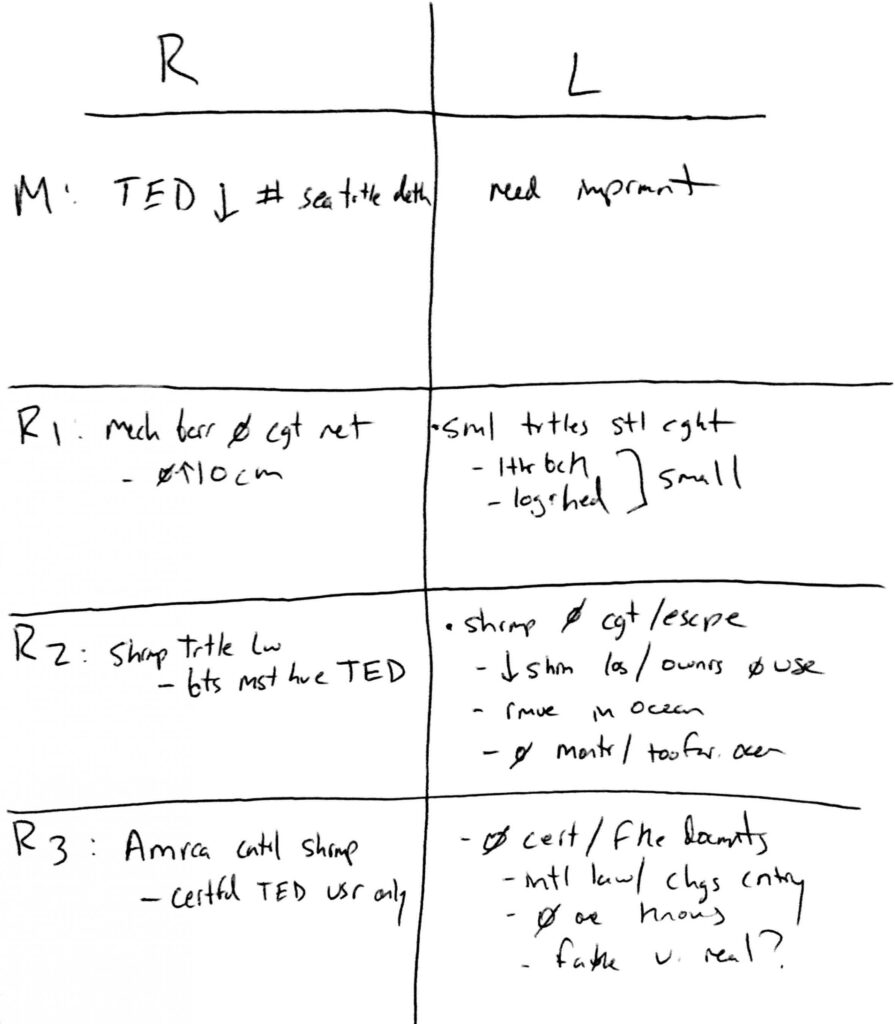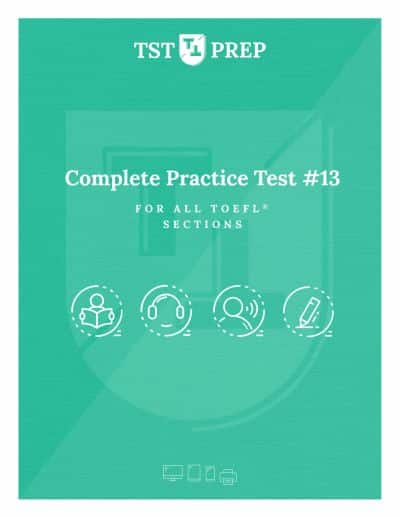We know it can feel impossible to write two complete essays in 30 minutes!
But today, we have some awesome TOEFL writing tips that will help you feel cool and confident on test day.
The first five tips are for the TOEFL integrated writing question, task number one. The last five tips are for the TOEFL Writing for an Academic Discussion question, task number two.
Here's a quick summary of our top 10 TOEFL Writing Tips
- Tip #1 – Pay careful attention to the reading passage because the listening passage will argue against each point made in the reading.
- Tip #2 – Practice taking short, but precise notes during the listening passage. You will only get to listen to it once.
- Tip #3 – Paraphrase the passages. One of the grading criteria on the TOEFL is vocabulary, and you will earn zero points if you simply quote the material.
- Tip #4 – Use lots of transitional words and phrases. They will help you develop your essay and connect your ideas.
- Tip #5 – Manage your time wisely. You only have 20 minutes to construct an essay of at least 250 words.
- Tip #6 – Be sure to add to the discussion. Do not repeat points and ideas from the discussion in your response.
- Tip #7 – Stick to a few simple verb tenses.
- Tip #8 – Try to include multiple sentences with more than one clause.
- Tip #9 – Plan to edit your essay for at least one minute at the end. There is no spellcheck on the TOEFL.
- Tip #10 – Practice writing at home and ask a teacher or trained TOEFL expert to give you a grade and point out your weakness.
Task 1 - Integrated Writing
Tip #1: Read, then listen
Task one provides you with two passages, a reading passage, and a listening passage. The reading passage will appear first. You will have three minutes to read the passage and take notes. After that, the reading passage will disappear, and then the listening passage will play for two or three minutes. Then you have 20 minutes to write your essay.
Here is a breakdown of task one:
Integrated Writing: Task Breakdown |
|
|---|---|
| Question Structure | Content |
| 1st | The writing section instructions will be read aloud. You can skip this introduction. |
| 2nd | You will be given an academic passage to read. This passage will contain between 250-300 words. When the clock starts, you will have three minutes to read the passage. After that, the passage disappears and an audio lecture starts. However, the reading passage will return when it's time to write. |
| 3rd | A lecture that addresses the content of the reading will start to play. The lecture will last for two to three minutes. |
| 4th | After the passage finishes, you will be asked a question. The question is almost always something like: "Summarize the points in the lecture, being sure to explain how they challenge specific points made in the reading" |
| 5th | The clock starts. You will have approximately 20 minutes to write an essay of at least 250 words. You must answer the question and report on the most important points from both the reading and listening. |
It is important to read the reading passage first because the professor in the listening passage is going to directly contradict the author in the reading passage.
Therefore, if you sleep on the reading passage, when the lecture begins, you may miss some vital information that you must include in your writing.
Let’s look at an example from TST Prep’s TOEFL Test #13 that you can download for free here to practice before test day.
Here’s the reading passage:
The shrimping industry relies on trawls to catch shrimp. Trawls are huge nets that are dragged behind boats in order to catch shrimp. Other animals, like sea turtles, are often caught inside these nets and soon die without sufficient oxygen. To help reduce the number of accidental deaths to sea turtles, engineers created a Turtle Excluder Device (TED), that must now be installed in all shrimping trawls. This one simple invention has greatly reduced the number of sea turtle deaths per year for a number of reasons.
First, the TED was specifically designed to help sea turtles. The TED mechanism has a mechanical barrier in the middle of the net that prevents any animal larger than ten centimeters from getting caught deep inside. Once the animal hits this metal grid, it tilts downward, providing that animal with a clear path to exit. Smaller animals, like shrimp, pass through the metal guard and get caught in the end of the trawl net, as usual.
Second, in order to make sure that fishermen use the Turtle Excluder Device, the “Shrimp-Turtle Law” was passed. It states that all trawling shrimping boats must have a TED installed. There are specific organizations in charge of monitoring shrimping vessels to ensure that their TEDs are properly installed and maintained.
Finally, America now tightly controls the import of shrimp. All shrimp products must come from a ship that is a certified user of TED-installed shrimping trawls. Countries, companies, or fishermen who do not comply with the “Shrimp-Turtle Law” are not allowed to sell their products in the US and some European countries. Since most shrimping businesses want to import their goods to as many locations as possible, they have decided to comply and install TEDs in their trawls.
- Main Idea: Turtle Excluder Devices (TEDs) have reduced the number of sea turtle deaths
- Reason 1: TEDs designed to prevent large animals from getting caught
- Reason 2: All boats must have a TED installed
- Reason 3: Shrimp importing is now tightly controlled
Tip #2: Take good notes
It is very, very important to take good notes during Task 1, especially on the Listening passage. There are two reasons for this:
- The reading passage will reappear after the lecture and be visible while you are writing. Therefore, while it is important to take note of the author’s position and main points, you don’t need to take as extensive notes on the reading passage.
- You are expected to write more about the listening passage than the reading. That’s right! In your answer, you should write twice as much about the professor’s viewpoint and counterarguments then the author. Therefore, it is vital that you take good notes during the lecture.
I can’t emphasize this enough: take good notes on the Listening passage!
You will be expected to write twice as much about the content of the listening passage than the reading.

Here’s a link to that audio passage again so you can practice taking notes and compare yours to my own.
Tip #3: Don't quote!
For the TOEFL integrated writing task, you are expected to explain the positions of the author and the professor, in your own words! It is very important, therefore, to paraphrase everything.
This is especially true of the reading passage. Remember, while you are writing your essay, the reading section will be right in front of you. If you directly quote the author, the TOEFL e-rater system will pick up on this and it can lead to a reduction in your score!
For example, let’s say that the reading passage states:
“There are many who argue that corn ethanol should replace fossil fuel gas as the primary source for running cars.”
DON’T say in your answer: “The author discusses how there are many who argue that corn ethanol should replace fossil fuel gas as the primary source for running cars.”
This is a huge mistake that many students make!
Instead, paraphrase the author’s position, such as: “The author discusses the advantages of switching from fossil fuels to the alternative energy source: corn-based ethanol.”

Tip #4: Use lots of transitional words and phrases
Transitional words and phrases are a crucial component of your writing, especially in TOEFL Writing task one. You will have to transition between contrasting points of view in both the reading and listening passage. The best way to keep your essay cohesive is to transition between ideas with these discourse markers.
They will prove to the TOEFL grader and e-rater that you have a firm grasp on both the English language and North American academic essay structure
Here is a list of some common transitional words and phrases:
TRANSITION WORDS AND PHRASES |
||
|---|---|---|
| Purpose | TOEFL Essay Location | Words and Phrases |
| Adding (elaborating) | (integrated) - Reporting on points from the listening passage in the body paragraphs (discussion) - When explaining your reasons and developing your examples |
actually, additionally, also, as well, as a matter of fact, for example, for instance, in addition, believe it or not, furthermore, indeed, in fact, moreover, such as |
| Emphasizing | (integrated) - Reporting on points from the listening passage in the body paragraphs (discussion) - When explaining your reasons and developing your examples |
above all, as a matter of fact, especially, indeed, in fact, most importantly, obviously |
| Showing cause and effect (connecting) | (discussion) - When you are connecting your example to the topic | as a result, consequently, hence, therefore, thus |
| Contrasting | (integrated) - When transitioning to the point of view of the listening in body paragraphs (discussion) - When recognizing the opposing argument |
although, at the same time, but, contrary to, even so, even though, however, in contrast to, nevertheless, nonetheless, on the other hand, still, when in fact, while, yet, whereas |
| Ordering | (integrated) -The first sentence of each body paragraph (discussion) - When providing more than one reason for your stance on the topic |
afterward, finally, first (second…) in the first place secondly, another reason, in the past, later, next, now, subsequently, while |
| Concluding | (integrated) - Located in the conclusion paragraph, which is optional for this essay (discussion) - In the last sentence of your response if you include a conclusion |
all in all, as noted above, finally, in conclusion, in short, in the end, on the whole, to conclude, to sum up |
Tip #5: Time management
For the integrated writing task, you only have 20 minutes to write your essay! Therefore, while time management is important throughout the TOEFL, it is especially important on this task.
You should spend approximately two minutes taking notes and outlining your answer, three minutes writing your introduction paragraph, eleven minutes writing the body paragraphs, two minutes for the conclusion, and the last three minutes for editing.
Here is the time breakdown for task one of the TOEFL writing section:
Integrated Essay Time Breakdown |
|
|---|---|
| Minutes | Tasks |
| 0-2 | Gather your notes and outline the essay |
| 3-5 | Write your introduction |
| 6-16 | Write your body paragraphs (2-3) |
| 17-18 | Write your conclusion |
| 19-20 | Edit your essay |
Be sure to download our Complete Practice Test right here so you can practice the entire test.
…but here is the essay response to the TOEFL integrated question on Turtle Excluder Devices.
The reading and the lecture are about the pros and cons of the Turtle Excluder Device (TED). The writer believes there are many benefits to the use of TED, and that it has decreased the number of sea turtles caught in trawls by shrimpers. The speaker in the listening passage disagrees. He claims there are still many issues with TED, and challenges each of the writer’s points.
First, the article posits that the design of TED includes a metal barrier inside the net that prevents larger animals from getting caught. Additionally, it says, TED also provides a path for the sea turtles to exit. However, the professor points out that small and mid-sized turtles still get caught deeper in the trawls. He states this is because the metal barrier only prevents creatures larger than ten centimeters to pass through it.
Also, the author notes that laws have been passed requiring shrimp boats to have TED and use it properly. The lecturer rebuts this argument. He says that it is impossible for organizations to regulate the fishermen while they are fishing for shrimp and that they can just remove the TED right before putting the nets into the ocean. Furthermore, he argues that they are inclined to do this because sometimes TED can also prevent shrimp from passing into the depths of the trawls, which decreases their profits.
Another reason the writer feels that TED is beneficial is that under import regulations, the shrimp sold in the US can only come from suppliers who are certified TED users. Again, the speaker holds there are flaws in this argument. He suggests that there are many boat owners who claim to be TED-certified, but, in reality, have fake documentation. The lack of consistency in TED certification from country to country allows many to deceive ports and sell their shrimp anyway.
To sum up, both the author and the lecturer hold conflicting views about TED.
Five more to go…
Still with me?
Awesome (just like these tips).
Now, let’s take a look at our last five tips for the TOEFL Writing section.
Task 2 - Writing for an Academic Discussion
Tip #6: Be sure to add to the discussion
On July 26, 2023, ETS introduced a new TOEFL Writing question called Writing for an Academic Discussion. It replaced the Independent Writing task.

For writing task #2, you have ten minutes to read the discussion and then write a response of 100 words or more.
In the example above, the professor poses a question about whether or not globalization has a positive or negative effect on society. Bryan believes globalization is positive because it brings people and cultures closer together, while Alex thinks globalization leads to the exploitation of developing countries.
When it is time to write, be sure to ADD to the discussion. Do not just repeat the same points made by the other students.
Look at the sample response below. The points highlighted are additional ideas that contribute to the discussion.
In my opinion, globalization is a positive force in the world today. My personal belief is that when nations interact together, it leads to less suffering. For example, people who suffer from natural catastrophes can import goods and services to help mitigate their losses and recover quickly. Citizens of nations who may be going through war or famine can flee to neighboring countries for shelter. I understand Alex’s concern over cultural homogenization, but I believe she misses another critical point. Much of the food found in grocery stores around the world is imported. Our very diet is due to the international trade partnerships and alliances forged over the last half of the 20th century. International trade and travel are not possible in a world without globalization, which is why I believe it is crucial to maintain our current global policies for a safer world with a higher standard of living.
On test day, it is fine to agree or acknowledge the points made in the discussion; just be sure that the majority of your response to the Writing for an Academic Discussion question further develops the online conversation.
Tip #7: Stick to a few simple verb tenses
- Simple present
- Simple past
- Present perfect
In my opinion, globalization is a positive force in the world today. My personal belief is that when nations interact together, it leads to less suffering. For example, people who suffer from natural catastrophes can import goods and services to help mitigate their losses and recover quickly. Citizens of nations who may be going through war or famine can flee to neighboring countries for shelter. I understand Alex’s concern over cultural homogenization, but I believe she misses another critical point. Much of the food found in grocery stores around the world is imported. Our very diet is due to the international trade partnerships and alliances forged over the last half of the 20th century. International trade and travel are not possible in a world without globalization, which is why I believe it is crucial to maintain our current global policies for a safer world with a higher standard of living.
But hold on a second.
Your grammar in the TOEFL Writing section can’t be too simple, and there is one more tip to keep in mind.
Tip #8: Try to include multiple sentences with more than one clause
According to Michael Goodine at Test Resources, the TOEFL Writing e-rater likes writing samples that include sentences with subordinating and/or coordinating conjunctions.
A subordinating conjunction is a word or phrase that links a dependent clause to an independent clause, and a coordinating conjunction joins two elements of equal importance.
Check out the table below for a handy list of both.
It is not required to include these conjunctions in your response, but it will help you craft sentences with two or more clauses, which will have a positive impact on your score.
I have highlighted the sentences from the globalization example response that include multiple clauses.
In my opinion, globalization is a positive force in the world today. My personal belief is that when nations interact together, it leads to less suffering. For example, people who suffer from natural catastrophes can import goods and services to help mitigate their losses and recover quickly. Citizens of nations who may be going through war or famine can flee to neighboring countries for shelter. I understand Alex’s concern over cultural homogenization, but I believe she misses another critical point. Much of the food found in grocery stores around the world is imported. Our very diet is due to the international trade partnerships and alliances forged over the last half of the 20th century. International trade and travel are not possible in a world without globalization, which is why I believe it is crucial to maintain our current global policies for a safer world with a higher standard of living.
Tip #9: Take the time to edit!
One of the best TOEFL Writing tips I could possibly share here is to leave yourself time to edit. Plan on finishing your essay around the 9-minute mark so you have at least a minute to edit your essay.
It’s annoying, I know.
Especially since, at this point, you will have taken the test for almost two hours.
Remember, there is no spellcheck on the exam. That’s right, you will be responsible for finding spelling and grammar mistakes yourself. Also, be sure to pay special attention to spacing and punctuation.
There is no automatic spellcheck on the TOEFL exam. You will be responsible for typing and correcting spelling and grammatical mistakes.
So, always give yourself a minute or more to proofread your essays and practice writing with spellcheck turned off!
Here are some common mistakes that are easy to spot:
- Spelling errors
- Capitalization and spacing mistakes
- Problematic introduction sentence
- Personal areas of weakness (article usage, subject-verb agreement, etc.)
- Proper verb tense
Read your response aloud quietly. Listen to hear if your sentences sound correct. If part of your response sounds strange, you may have some awkward grammar that needs to be fixed.
Tip #10: Get feedback
While preparing for the TOEFL writing section, it is crucial for you to get your hands on some practice questions.
And to get valuable feedback from a qualified TOEFL instructor who knows exactly what you need to write to earn a high score in the writing section. Relying on yourself or a teacher you know will certainly help, but you will not be able to reach your full potential without advice from an experienced instructor.
Therefore, the last tip while preparing for the TOEFL is to get help from a trained professional at TST Prep.
Conclusion
If you haven’t already, be sure to download TST Prep’s Complete Test #13 where you can see these sample essays and more.
Was there anything we missed?
If you have more TOEFL Writing tips, please don’t hesitate to let us know in the comments section below.
And, as always, we are here to help if you have any questions or concerns, contact@tstprep.com










77 Comments
Mawusi Kudozia
Hello,
The tips are easy to understand but can we have tips on the conclusion of an independent writing.
Josh
Hi Mawusi, and thanks for the question. I recommend downloading our “advanced writing templates” so you can see an example of the independent writing conclusion.
Here’s a link: https://tstprep.com/opt-in-ultimate-toefl-writing-templates/
Vivian Rodriguez
Thank for your time and effort to show us how to correctly write and independent writing essay. I have taken the Toefl test four times before and never pass the writing section. Because of your lesson an your tips, I feel more confident now. Thank you so much
Josh
That’s great Vivian and glad to hear you feel more confident. You might want to check out our evaluation and lesson packages in the TOEFL store tab as well since we specialize in helping students like you improve your writing score. Thanks for leaving a comment!
Judith Grau
GREAT TIPS, REALLY EASY TO UNDERSTAND AND FOLLOW. THANK YOU SO MUCH
Josh
No problem Judith and thank you for taking the time to leave a comment. It means a lot!
Regina
I think this is the best TOEFL Practice site I have landed on. It literally walks you through every step in tackling questions. Thank you
Josh
Nice, thank you for the compliment, Regina. Let me know if there is any other way we can help 🙂
Ali.ph.
Hello!
Thanks for the great tips.
Just one question! Is it a good idea in the independent task to support one side in the first body paragraph, and then, to talk about disadvantages of the other side or sides in the second body paragraph? (especially, for Three-choice questions and Pick-a-side questions)
Josh
Hi Ali and great question.
We usually do NOT recommend this approach, but there are a lot of different ways to score well on the writing and I don’t think you will get negatively penalized for this.
I hope that helps.
Ajay Kathuria
this blog is perfect as it contains all the knowledge required to a person about TOEFL, thank you so much for sharing this.
Josh
Thank you for your kind words Ajay, much appreciated 🙂
T
Thank you indeed for the tips. They are perfectly useful.
Josh
That’s great to hear and thank you for taking the time to leave a comment. Let me know if there is any other way I can help.
Hamed
Hi Josh, this site and especially this article are just fabulous! These tips illustrate that a very careful and professional analyses are done which also needs plenty of experiences dealing with TOEFL test takers. Anyway, thanks for these informative articles and keep on keeping on!
Josh
Thank you Hamed, I’ll keep doing my best.
Omid Habibi
Hi Josh. If we are given a three choice question, can we choose one of them and explain about negative aspects of the other two choices within the essay? Thank you, and God bless you and your incredibly wonderful team.
Josh
Hi there and thank you for the compliment! We appreciate it 🙂
There are many different wats to score high for an independent speaking question. The most important consideration is that you answer the question in a comfortable and natural manner.
So, in short, yes you can do that!
Ekaterina
I found difficult to write 300+ words independent essay. Is there any universal phrases that can be added to the essay when I’m nearly out of time and need to add more words just to meed requirements?
Josh
Hi there Exaterina and good question. I will link to a document that has topics, templates and sample essays. You may find a few ideas in here – https://drive.google.com/open?id=1L2O4JV4XaPuJrGsuCHK9sQNj7g49ND-p
Omid
Hello Josh. It is my great honor that I am familiar with you and your great team. I have a question about independent writing task. If we are given a three-choice prompt, can we write about two of them? Or we have to write about one of them and elaborate on that by mentioning two reasons? I would be grateful if you help me with this. Thanks a lot
Josh
Hi there Omid and this is a great question. In theory, I would say that “choose two” is fine, however, in practice, I believe it might be a mistake. Pay close attention to the question. If the question says “choose one” be sure to choose just one. If the question does not specify, then you can choose more than one (however, I do believe they usually say to ‘choose one’)
Madinah
Hi, first of all I want to thank you and your team for great tips and articles. Second, I have a question; When we have an advantage/disadvantage question at independent writing task, is it the best way to explain advantages in first paragraph and then the disadvantages in another paragraph, and lastly conclude them in another paragraph? I would appreciate it if you guide me. Thanks, 🙂
Josh
Hi there Madinah and I have good news, the advantage and disadvantage question only shows up in the speaking, NOT the writing. Also, we haven’t had any reports on this type of question in the speaking section for the past six months or so. I hope that answers your question.
Omid Habibi
Hi Josh, I really appreciate your efforts. My question is about writing numbers in the essays. In digits or words? Thanks about replying.
Josh
That’s a great question. I follow the standard rule for the numbers 1-10 they should be written out (one, two, three…) and the rest you can write as numbers (i.e. 125, 1997).
I hope that answers your question.
Rayan Abdelmagid
Hi Josh, I am planning to take the TOEFL in few months and I would like to say that your articles and youtube videos are treasure, thank you so much for all the effort you put on those materials and thank you for the ongoing support you give to the test takers, we need it for sure. 🙂
Josh
Thank you for taking the time to leave such kind words. It’s messages like this that keep me motivated 🙂
Alaa
Thanks so much for your tips, really helpful. I have taken the TOEFL twice before and this is hopefully the last. my suggestion; i wish you post some helpful tips for reading too. i mean in details like here thanks.
Alaa
Also, a question, should i leave a space between written passages in either independent or integrated task?
Josh
Hi Alaa and good question. I would put a space between each paragraph, however, it is not necessary to have a space between each line of text. I hope that answers your question.
Sara
Hi Josh! These tips are brilliant, thank you so much. I wanted to ask you one thing though: I’ve always had troubles respecting word limits and when I practice for the
TOEFL writing I always tend to write at least 50 words more than the suggested amount (which I think is 200 for task 1 and 300 for task 2).
Do you think this could affect my results in any significant way?
Thank you!
Josh
Hi Sara and let me give you the same answer I gave Tamara. We usually recommend more than ETS. We have found a positive correlation between word count and essay score. So, the more you write, the better. You will certainly not be deducted points for writing over the word limit (unless your writing is sloppy and contains many errors). I hope that answers your question.
Josh
And thank you for your kind words 🙂 I appreciate it!
Englay
Hi Mr. Josh
I want your free TOEFL PDF (#12)
Josh
Hi there Englay, and I think this is the link you are looking for. I hope it helps – https://drive.google.com/drive/u/1/folders/1nCHX-7yp94ovU6_CygYMza1IY7fhqBM-
Englay
And also thank you for your tips. They are extremely helpful
Josh
Thank you for the compliment! Much appreciated 🙂
Erfan
Hello Josh, How can I have this post in PDF format? Is it possible to send me the PDF file of this post ??
Josh
Hi Erfan and thank you for asking. Unfortunately, we do not have this post in PDF format but we have our TOEFL Writing Guide which includes tips like this, along with a lot of other useful information. I think you will find this document even more helpful. Here is the link – https://drive.google.com/file/d/12JWgyMLAAUM2z4GDDpTDbMXCXelkYS0h/view?usp=sharing
James Jhan
Thanks a lot for sharing the tips and the analysis, I really appreciate it!
Nikitha Crasta
Hi Josh, I’m taking my test in a few minutes. Thank you so much for the free material on the website. It has definitely helped me make my own template!
Josh
Thanks for leaving a comment Nikitha. How did the test go? I’m always interested to hear if anything was surprising/interesting/etc.
Nikitha Crasta
The test was alright! I haven’t received my scores yet, except for Reading (26) and Listening (29). The questions asked were congruent to the examination pattern. I couldn’t really relate to the personal opinion question asked in the speaking section. I found the reading section quite tough compared to everything else. In the end, it wasn’t so bad considering I started prep 24 hours before the exam. If I had put in the effort, I would’ve been able to do well.
Oya
Hi Josh. I’m preparing to write the TOEFL exam as a deaf test taker. I have practiced a lot, but the problem is the reading section. I can’t figure out how I answer to the reading section questions.
Josh
Have you considered seeing if perhaps you can be allowed extra time? I know in certain situations it is possible, but I’m not sure it would pertain to the Reading section. It might be worth you checking with ETS. Outside of that, have you thought about maybe taking the group reading course? I think it might really help you.
Thomas
Hello, I’m preparing for TOEFL, and I found a weird subject for the independent subject. “The average global life expectancy went from 29 years old in 1800 to 71 years old in 2015. According to you, what is the main cause for such a change?”. Do you know if it is possible to have a question like this? Thank you for your help.
Josh
Hi there and thank you for your question. This does indeed sound like a reasonable topic since anyone could have an opinion on it. It is a bit strange but definitely possible. (I’ve seen weirder). This would also be difficult because you would have to use past unreal unconditional forms and sentences like “It could have been” “might have been because”, etc. Hope that helps!
Rob
Hello Josh. What do “int” and “ind” mean? You used these in the TOEFL Writing Transitional Phrases table without explaining them. Thanks.
Josh
Hi Rob, and my apologies. I should clarify that. The “int” stands for “integrated writing (task 1),” and the “ind” stands for independent writing (task #2).
Ruth
Point 7 isn’t true (but perhaps you needed just one more to make 10 tips instead of 9?)
I took both sides all the time when I took the TOEFL, and got a 119 (and the reason I missed one point was the speaking, where I forgot to mention two specific examples).
Cheers!
Josh
Hi Ruth and thank you for taking the time to leave a comment. Congrats on your score, that’s incredible. In regards to your opinion on tip #7 ” HAVE A CLEAR OPINION AND STICK TO IT”, it is not put there arbitrarily to inflate the number of tips. We have found that students who fail to have a concrete opinion tend to have difficulty developing the topic and writing with clarity. This is not always the case and you can write a perfect essay by arguing both sides of the argument, generally speaking, however, it is easier to write a clear and well-developed essay when taking one clear side of an issue.
Iman
Hi Josh,
First, thanks a million for this intelligent and helpful content; you are a great tutor. I found that the time management section has a small mistake with summing the minutes suggested for each step. 2 minutes outline + 3 minutes introduction + 11 minutes body + 2 minutes conclusion + 3 minutes editing = 21 minutes!
Josh
Hi Inman, thanks for pointing that out. We will have a look. I would maybe say 2 minutes for an introduction would be better. 🙂
Iman
Great! Thanks again.
Gopal
Hi Josh,
The sample for Task 1 provided on the ETS website is a bit different from the one you wrote. It solely focuses on the lecture while only saying, “That refutes that point from reading.” Could you have a look and recommend me some tips?
Josh
Hi, thanks for your question. To add length to your essay, we suggest including a bit more from the reading section. It can also help you in making sure each point from the listening matches a point referenced in the reading.
Hossein
Hi Josh.
Thank you a lot. This post was very useful for me.
Parisa
Thanks for this invaluable article🙏🏻.
Lin
Excellent samples
Shreya Sen
Hi Josh, thank you for your wonderful support. I want to ask you that for int task, while the reading passage is on history topic, should I stick to past tense or not? Like “the passage elaborates that the Greek sculpture was…”. Please provide another academic test opportunity for free like the previous one.
Josh
Hi Shreya, Thank you very much for your question. In general, you should use the tense the lecturer uses, so if the topic is about the ancient Romans, you should be writing in the past, etc.
Valery Burusu
Josh,
I enjoyed how you empowered and equipped us, those who are preparing ourselves to do the TOEFL test. I strongly believe that I will get a good score, even if it is tough.
Josh
Thanks for taking the time to comment and best of luck on your test!
Mohammad
Hi Josh, I use an online grammar checker tool. It is the most famous one. There are 2 types of sections: correctness and clarity.
As you know better than me we must use some grammar structures such as passive. However, in spite of the correctness of these grammar, they become as an error in clarity, not the correctness section.
I use grammar such as what-cleft, which sounds like a kinda error in clarity, but it is ok in correctness. It sounds like grammar is on the opposite side of clarity, but it has a score in the writing section. Which must I prefer? Clarity or grammar
Josh
Thank you very much for your question. Speaking very generally, it is most important that the grammar is correct. After it is corrected, some grammar checkers may offer you a better way to say what you wanted to, but that doesn’t mean the first way is completely wrong. So the short answer is correct grammar first, clarity second.
Jennifer
Hi Josh, I’ve followed the test preparation for a long time, and I enjoy my time with your strategies and hard work for this community.
Thank you for that. I have struggled with writing with more accuracy, but I know how I can increase that.
Josh
Thanks for taking the time to comment. It means a lot!